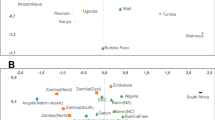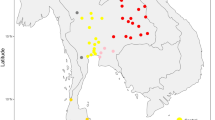Abstract
The out-of-Africa scenario1 has hitherto provided little evidence for the precise route by which modern humans left Africa. Two major routes of dispersal have been hypothesized: one through North Africa into the Levant, documented by fossil remains2, and one through Ethiopia along South Asia, for which little, if any, evidence exists3. Mitochondrial DNA (mtDNA) can be used to trace maternal ancestry. The geographic distribution and variation of mtDNAs can be highly informative in defining potential range expansions and migration routes in the distant past. The mitochondrial haplogroup M, first regarded as an ancient marker of East-Asian origin4,5, has been found at high frequency in India6 and Ethiopia7, raising the question of its origin. (A haplogroup is a group of haplotypes that share some sequence variations.) Its variation and geographical distribution suggest that Asian haplogroup M separated from eastern-African haplogroup M more than 50,000 years ago. Two other variants (489C and 10873C) also support a single origin of haplogroup M in Africa. These findings, together with the virtual absence of haplogroup M in the Levant and its high frequency in the South-Arabian peninsula, render M the first genetic indicator for the hypothesized exit route from Africa through eastern Africa/western India. This was possibly the only successful early dispersal event of modern humans out of Africa.
This is a preview of subscription content, access via your institution
Access options
Subscribe to this journal
Receive 12 print issues and online access
$209.00 per year
only $17.42 per issue
Buy this article
- Purchase on Springer Link
- Instant access to full article PDF
Prices may be subject to local taxes which are calculated during checkout



Similar content being viewed by others
References
Lewin, R. Africa: cradle of modern humans. Science 237, 1292–1295 (1987).
Stringer, C.B., Grün, R., Schwarcz, H.P. & Goldberg, P. ESR dates for the hominid burial site of Skhul in Israel. Nature 338, 756–758 (1989).
Cavalli-Sforza, L.L., Menozzi, P. & Piazza, A. The History and Geography of Human Genes (Princeton University Press, Princeton,1994).
Torroni, A. et al. Asian affinities and continental radiation of the four founding Native American mtDNAs. Am. J. Hum. Genet. 53, 563–590 (1993).
Chen, Y.S., Torroni, A., Excoffier, L., Santachiara-Benerecetti, A.S. & Wallace, D.C. Analysis of mtDNA variation in African populations reveals the most ancient of all human continent-specific haplogroups. Am. J. Hum. Genet. 57, 133–149 (1995).
Passarino, G., Semino, O., Bernini, L.F. & Santachiara-Benerecetti, A.S. Pre-Caucasoid and Caucasoid genetic features of Indian population revealed by mtDNA polymorphisms. Am. J. Hum. Genet. 59, 927–934 (1996).
Passarino, G. et al. Different genetic components in the Ethiopian population, identified by mtDNA and Y-chromosome polymorphisms. Am. J. Hum. Genet. 62, 420–434 (1998).
Excoffier, L. & Langaney, A. Origin and differentiation of human mitochondrial DNA. Am. J. Hum. Genet. 44, 73–85 (1989).
Watson, E., Forster, P., Richards, M. & Bandelt, H.-J. Mitochondrial footprints of human expansions in Africa. Am. J. Hum. Genet. 61, 691–704 (1997).
Mountain, J.L. et al. Demographic history of India and mtDNA-sequence diversity. Am. J. Hum. Genet. 56, 979–992 (1995).
Côrte-Real, H.B.S.M. et al. Genetic diversity in the Iberian Peninsula determined from mitochondrial sequence analysis. Ann. Hum. Genet. 60, 331–350 (1996).
Macaulay, V. et al. The emerging tree of West Eurasian mtDNAs: a synthesis of control-region sequences and RFLPs. Am. J. Hum. Genet. 64, 232–249 (1999).
Krings, M. et al. mtDNA analysis of Nile River Valley populations: a genetic corridor or a barrier to migration? Am. J. Hum. Genet. 64, 1166–1176 (1999).
Forster, P., Harding, R., Torroni, A. & Bandelt, H.-J. Origin and evolution of Native American mtDNA variation: a reappraisal. Am. J. Hum. Genet. 59, 935–945 (1996).
Ozawa, T. et al. Patients with idiopathic cardiomyopathy belong to the same mitochondrial DNA gene family of Parkinson's disease and mitochondrial encephalomyopathy. Biochem. Biophys. Res. Commun. 177, 518–525 (1991).
Ozawa, T. Mechanism of somatic mitochondrial DNAs mutations associated with age and diseases. Biochim. Biophys. Acta 1271, 177–189 (1995).
Lutz, S., Weisser, H.J., Heizmann, J. & Pollak, S. Location and frequency of polymorphic positions in the mtDNA control region of individuals from Germany. Int. J. Legal. Med. 111, 67–77 (1998); erratum: 112, 145–150 (1999).
Horai, S., Hayasaka, K., Kondo, R., Tsugane, K. & Takahata, N. Recent African origin of modern human revealed by complete sequences of hominoid mitochondrial DNAs. Proc. Natl Acad. Sci. USA 92, 532–536 (1995).
Lahr, M.M. & Foley, R.A. Multiple dispersals and modern human origins. Evol. Anthropol. 3, 48–60 (1994).
Jin, L. et al. Distribution of haplotypes from a chromosome 21 region distinguishes multiple prehistoric human migrations. Proc. Natl Acad. Sci. USA 96, 3796–3800 (1999).
Tishkoff, S.A. et al. Global patterns of linkage disequilibrium at the CD4 locus and modern human origins. Science 271, 1380–1387 (1996).
Vigilant, L.A., Wilson, A.C. & Harpending, H. African populations and the evolution of human mitochondrial DNA. Science 253, 1503–1507 (1991).
Torroni, A. et al. mtDNA analysis reveals a major late Paleolithic population expansion from southwestern to northeastern Europe. Am. J. Hum. Genet. 62, 1137–1152 (1998).
Bandelt, H.-J., Forster, P., Sykes, B.C. & Richards, M.B. Mitochondrial portraits of human populations using median networks. Genetics 141, 743–753 (1995).
Brown, M.D. et al. mtDNA haplogroup X: ancient link between Europe/Western Asia and North America? Am. J. Hum. Genet. 63, 1852–1861 (1998).
Starikovskaya, Y.B., Sukernik, R.I., Schurr, T.G., Kogelnik, A.M. & Wallace, D.C. mtDNA diversity in Chukchi and Siberian Eskimos: implications for the genetic history of ancient Beringia and the peopling of the New World. Am. J. Hum. Genet. 63, 1473–1491 (1998).
Schurr, T.G., Sukernik, R.I., Starikovskaya, Y.B. & Wallace, D.C. Mitochondrial DNA variation in Koryaks and Itel'men: population replacement in the Okhotsk Sea-Bering Sea region during the Neolithic. Am. J. Phys. Anthropol. 108, 1–39 (1999).
Graven, L. et al. Evolutionary correlation between control region sequence and restriction polymorphisms in the mitochondrial genome of a large Senegalese Mandenka sample. Mol. Biol. Evol. 12, 334–345 (1995).
Rando, J.C. et al. Mitochondrial DNA analysis of Northwest African populations reveals genetic exchanges with European, Near-Eastern, and sub-Sharan populations. Ann. Hum. Genet. 62, 531–550 (1998).
Kolman, C.J., Sambuughin, N. & Bermingham, E. Mitochondrial DNA analysis of Mongolian populations and implications for the origin of New World founders. Genetics 142, 1321–1334 (1996).
Acknowledgements
We thank F. Falaschi for the Kenya Oromo part of the samples; A. Torroni for information on the haplogroup M frequency in the South-Arabian peninsula; D. Toniolo for the use of the ABI sequencer; R. Ricotti for help in DNA sequencing; and V. Macaulay and S. Nørby for drawing our attention to the Ozawa et al. 15 and Ozawa 16 papers. This research was supported by the Ministry of University (PRIN ex 40%; to A.S.S.-B.). L.Q.-M. is a Marie Curie Fellow of the EC (ERBFMBICT-961830).
Author information
Authors and Affiliations
Corresponding author
Rights and permissions
About this article
Cite this article
Quintana-Murci, L., Semino, O., Bandelt, HJ. et al. Genetic evidence of an early exit of Homo sapiens sapiens from Africa through eastern Africa. Nat Genet 23, 437–441 (1999). https://doi.org/10.1038/70550
Received:
Accepted:
Issue Date:
DOI: https://doi.org/10.1038/70550
This article is cited by
-
Climatic windows for human migration out of Africa in the past 300,000 years
Nature Communications (2021)
-
The story of the lost twins: decoding the genetic identities of the Kumhar and Kurcha populations from the Indian subcontinent
BMC Genetics (2020)
-
Haplogroup Structure and Genetic Variation Analyses of 60 Mitochondrial DNA Markers in Southern Shaanxi Han Population
Biochemical Genetics (2020)
-
Y-Chromosome Marker Characterization of Epipaleolithic and Neolithic Groups of Southern India
Proceedings of the National Academy of Sciences, India Section B: Biological Sciences (2020)
-
Investigating the West Eurasian ancestry of Pakistani Hazaras
Journal of Genetics (2019)



